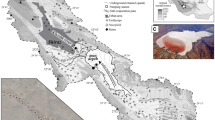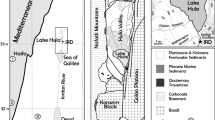Abstract
Sedimentary properties of the fossil-bearing deposits of Lake Sihetun (Yixian Formation, Lower Cretaceous) were investigated on a high-resolution, sub-millimetric scale. Data were obtained from three excavations and 50 thin-sections. Lake evolution is subdivided into four phases, of which Phases 2 and 3 provided suitable conditions for excellent fossil preservation. Six microfacies are recognized within these two phases: (1) allochthonous, siliciclastic laminae (26.1 μm thick on average), (2) chrysophycean cyst accumulations, (3) tuffaceous silt, (4) lacustrine chemical precipitates, (5) tuff and (6) normal-graded, sandy to silty siliciclastics. Phase 2 is characterized by Microfacies 1–5 and Phase 3 by Microfacies 6. Biofilms are common, and mass occurrences of framboids (pyrite pseudomorphs) are occurring in sediments of Phase 2. Varves can be verified for Microfacies 2 and 4 (179 μm thick). Thicknesses of Microfacies 2 highly fluctuate depending on the occurrence of seasonal heavier rains, which led to deposition of tuffaceous silt layers (Microfacies 3). Meromictic conditions dominated Phase 2, but recurrent mixing is demonstrated by short-lived colonization events by a benthic invertebrate fauna. The transition of Phase 2 to holomictic Phase 3 is marked by a dramatic increase in sediment yield associated with a change from dry to humid climates. Fossil preservation differs according to the diverse physical and chemical conditions during lake evolution. Phase 2 yields framboid replacement of organic tissue and excellent preservation of growth increments of clam-shrimp carapaces, which are poorly preserved in Phase 3. Conversely, though exhibiting a different mode of preservation, insect fossils are superbly preserved as dark stains sealed by silica coatings during Phase 3.















Similar content being viewed by others
References
Amiot R, Wang X, Zhou Z, Wang X, Buffetaut E, Lécuyer C, Ding Z, Fluteau F, Hibino T, Kusuhashi N, Mo J, Suteethorn V, Wang Y, Xu X, Zhang F (2011) Oxygen isotopes of East Asian dinosaurs reveal exceptionally cold Early Cretaceous climates. Proc Natl Acad Sci USA 108:5179–5183
Anderson RY (1964) Varve calibration of stratification. Kans Geol Surv Bull 169:1–20
Anderson RY, Dean WE (1988) Lacustrine varve formation through time. Palaeogeogr Palaeoclimatol Palaeoecol 62:215–235
Anderson RY, Dean WE, Bradbury JP (1993) Elk Lake in perspective. In: Bradbury JP, Dean WE (eds) Elk Lake, Minnesota: evidence for rapid climate change in the North-Central United States. Boulder, Colorado, Geol Soc Am Spec Pap, vol 276, pp 1–6
Barrett PM (2000) Evolutionary consequences of dating the Yixian Formation. Trends Ecol Evol 15:99–103
Behr H-J (2002) Magadiite and Magadi chert: a critical analysis of the silica sediments in the Lake Magadi Basin, Kenya. SEPM Spec Publ 73:257–273
Berner RA (1981) A new geochemical classification of sedimentary environments. J Sediment Petrol 51:359–365
Berner RA (1984) Sedimentary pyrite formation: an update. Geochim Cosmochim Acta 48:605–615
Bourrelly P (1963) Loricae and cysts in the Chrysophyceae. Ann NY Acad Sci 108:421–429
Chang S-C, Zhang H, Renne PR, Fang Y (2009) High-precision 40Ar/39Ar age for the Jehol Biota. Palaeogeogr Palaeoclimatol Palaeoecol 280:94–104
Chen P-J (1999) Distribution and spread of the Jehol Biota. Palaeoworld 11:1–6
Cheng RH, Liu ZJ, Wang DP (1997) Types of filling sequences in the continental basins, examples from Mesozoic basins, western Liaoning province. Acta Sedimentol Sin 15:166–170 (in Chinese)
Cloud P (1976) Beginnings of biospheric evolution and their biogeochemical consequences. Paleobiol 2:351–387
Ding Q, Zhang L, Guo S, Zhang C, Peng Y, Jia B, Chen S, Xing D (2003) Paleoclimatic and palaeoenvironmental proxies of the Yixian Formation in the Beipiao area, western Liaoning. Geol Bull China 22:186–191 (in Chinese)
Dixit AS, Dixit SS (1989) Surface-sediment chrysophytes from 35 Quebec lakes and their usefulness in reconstructing lake-water pH. Can J Bot 67:2071–2076
Duff KE, Zeeb BA, Smol JP (1995) Atlas of chrysophycean cysts. In: Dumont HJ (ed) Developments in hydrobiology. Kluwer, Dordrecht, pp 1–189
Eloranta P (1995) Biogeography of chrysophytes in Finnish lakes. In: Sandgren CD, Smol JP, Kristiansen J (eds) Chrysophyte algae, ecology, phylogeny and development. Cambridge University Press, Cambridge, pp 214–231
Enkin RJ, Yang Z, Chen Y, Courtillot V (1992) Paleomagnetic constraints on the geodynamic history of the major blocks of China from the Permian to the present. J Geophys Res 97:13953–13989
Farrand M (1970) Framboidal sulphides precipitated synthetically. Miner Depos 5:237–247
Fürsich FT, Sha J, Jiang B, Pan Y (2007) High resolution palaeoecological and taphonomic analysis of Early Cretaceous lake biota, western Liaoning (NE-China). Palaeogeogr Palaeoclimatol Palaeoecol 253:434–457
Grabau AW (1928) Stratigraphy of China, part 2, Mesozoic. Geological Survey of China, Peking
Gu Z (1962) The Jurassic and Cretaceous of China. Science Press, Beijing (in Chinese)
Jiang B, Sha J (2006) Late Mesozoic stratigraphy in western Liaoning, China: a review. J Asian Earth Sci 28:205–217
Jiang B, Sha J (2007) Preliminary analysis of the depositional environments of the lower Cretaceous Yixian formation in the Sihetun area, western Liaoning, China. Cretac Res 28:183–193
Jiang B, Fürsich FT, Sha J, Wang B, Niu Y (2011) Early cretaceous volcanism and its impact on fossil preservation in Western Liaoning, NE China. Palaeogeogr Palaeoclimatol Palaeoecol 302:255–269
Jiang B, Fürsich FT, Hethke M (2012) Depositional evolution of the early cretaceous Sihetun Lake and implications for regional climatic and volcanic history in western Liaoning, NE China. Sediment Geol 257–260:31–44
Kelts K, Hsü KJ (1978) Freshwater carbonate sedimentation. In: Lerman A (ed) Lakes—chemistry, geology, physics. Springer, New York, pp 295–323
Langbein WB, Schumm SA (1958) Yield of sediment in relation to mean annual precipitation. Trans Am Geophys Union 39:1076–1084
Leng Q, Yang H (2003) Pyrite framboids associated with the Mesozoic Jehol Biota in northeastern China: implications for microenvironment during early fossilization. Prog Nat Sci 13:206–212
Li J, Batten DJ (2007) Palynological evidence of an early cretaceous age for the Yixian formation at Sihetun, western Liaoning, China. Cretac Res 28:333–338
Liu T, Liu J, Chu G (2002) Early Cretaceous maars, depositional environments and their relationship to the fossil preservation in Sihetun, Liaoning, Northeast China. In: Zhou Z, Zhang F (eds) Proceedings of 5th symposium society avian paleontology evolution, pp 307–311
Lotter AF (1989) Evidence of annual layering in Holocene sediments of Soppensee, Switzerland. Aquat Sci 51:19–30
Müller G, Irion G, Förstner U (1972) Formation and diagenesis of inorganic Ca–Mg carbonates in the lacustrine environment. Naturwiss 59:158–164
Pan Y, Sha J, Fürsich FT, Wang Y, Zhang X, Yao X Dynamics of the lacustrine fauna from the Early Cretaceous Yixian Formation, China: implications of volcanic and climatic factors. Lethaia. doi:10.1111/j.1502-3931.2011.00284.x (in press)
Ragotzkie RA (1978) Heat budgets of lakes. In: Lerman A (ed) Lakes—chemistry, geology, physics. Springer, New York, pp 1–19
Reed SJB (2005) Electron microprobe analysis and scanning electron microscopy in geology. Cambridge University Press, Cambridge
Schäfer A (2005) Klastische Sedimente, Fazies und Sequenzstratigraphie. Spektrum, München
Siver PA (1988) Morphology and ecology of Mallomonas galeiformis (Chrysophyceae), a potentially useful paleolimnological indicator. Trans Am Microsc Soc 107:152–161
Siver PA (1995) The distribution of chrysophytes along environmental gradients: their use as biological indicators. In: Sandgren CD, Smol JP, Kristiansen J (eds) Chrysophyte algae, ecology, phylogeny and development. Cambridge University Press, Cambridge, pp 232–268
Sturm M (1979) Origin and composition of clastic varves. In: Schlüchter C (ed) Moraines and varves. Balkema, Rotterdam, pp 281–285
Sun G, Ji Q, Dilcher DL, Zheng S, Nixon KC, Wang X (2002) Archaefructaceae, a new basal angiosperm family. Science 296:899–904
Sweeney RE, Kaplan IR (1973) Pyrite framboid formation: laboratory synthesis and marine sediments. Econ Geol 68:618–634
Swisher CC III, Wang Y, Wang X, Xu X, Wang Y (1999) Cretaceous age for the feathered dinosaurs of Liaoning, China. Nature 400:58–61
Tappan H (1980) The paleobiology of plant protists. WH Freeman and Company, San Francisco
Wang H, Yang S, Li S (1983) Mesozoic and Cenozoic basin formation in east China and adjacent regions and development of the continental margin. Acta Geol Sin 57:213–223
Wilkin RT, Barnes HL (1996) Pyrite formation by reactions of iron monosulfides with dissolved inorganic and organic sulfur species. Geochim Cosmochim Acta 60:4167–4179
Xu X, Tang Z, Wang X (1999a) A therizinosauroid dinosaur with integumentary structures from China. Nature 399:350–354
Xu X, Wang X, Wu X (1999b) A dromaeosaurid dinosaur with a filamentous integument from the Yixian formation of China. Nature 401:262–266
Xu X, Zhou Z, Prum RO (2001) Branched integumental structures in Sinornithosaurus and the origin of feathers. Nature 410:200–204
Yang W, Li S, Jiang B (2007) New evidence for cretaceous age of the feathered dinosaurs of Liaoning: zircon U-Pb SHRIMP dating of the Yixian formation in Sihetun, northeast China. Cretac Res 28:177–182
Zhou Z, Barrett PM, Hilton J (2003) An exceptionally preserved lower cretaceous ecosystem. Nature 421:807–814
Zhu R, Pan Y, Shi R, Liu Q, Li D (2007) Palaeomagnetic and 40Ar/39Ar dating constraints on the age of the Jehol Biota and the duration of deposition of the Sihetun fossil-bearing lake sediments, northeast China. Cretac Res 28:171–176
Zolitschka B (1989) Jahreszeitlich geschichtete seesedimente aus dem Holzmaar und dem Meerfelder Maar. Z dtsch geol Ges 140:25–33
Acknowledgments
Research was supported by the 973 program grant (2012CB821905) and the National Science Foundation of China (grants 406032010, 40672077, 41172033). The authors benefited from discussions with R. Schöner, J. Sha, R. Koch, M. López Correa, J. Rust and B. Kremer. Y. Niu and C. Wu assisted us in the field. B. Leipner-Mata helped with the preparation of thin-sections.
Author information
Authors and Affiliations
Corresponding author
Electronic supplementary material
Below is the link to the electronic supplementary material.
Rights and permissions
About this article
Cite this article
Hethke, M., Fürsich, F.T., Jiang, B. et al. Seasonal to sub-seasonal palaeoenvironmental changes in Lake Sihetun (Lower Cretaceous Yixian Formation, NE China). Int J Earth Sci (Geol Rundsch) 102, 351–378 (2013). https://doi.org/10.1007/s00531-012-0799-7
Received:
Accepted:
Published:
Issue Date:
DOI: https://doi.org/10.1007/s00531-012-0799-7




